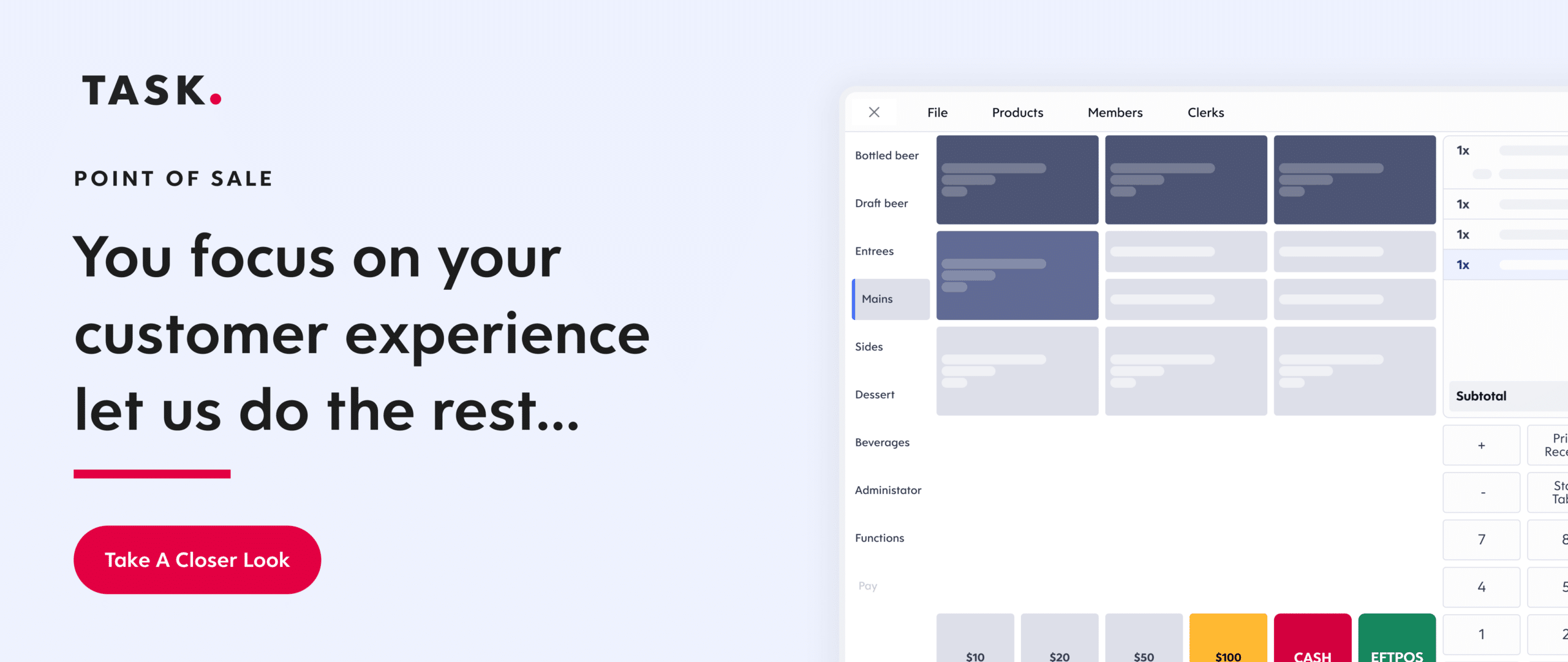Walk into nearly any restaurant, coffee shop, stadium, or event venue today, and you’ll find some version of POS software in action. From order-taking tablets to self-service kiosks and online delivery apps, POS is what connects customers with their favorite food brands.
With so many ordering channels now part of the daily customer experience, however, there is an evolving need for high-performance, adaptable technology to keep up with changing demands. POS technology is the beating heart of every digital tool – from inventory management systems to tracking sales data to handling payments and so much more.
As the capabilities of POS continue to evolve and customer expectations keep piling up, hospitality businesses need to be able to separate the temporary trends from the must-haves in restaurant technology.
The POS features you can’t live without
With the industry changing so quickly, it can be difficult to know exactly what you need to keep up with today’s customers and the competition. There are so many options out there when it comes to digital tools – so how do you pick the right ones?
As TASK’s President of North America John Laporte explains, “Making decisions about your digital transformation starts with carefully considering your customers, your connection with them, and what their needs are. From there, you’ll be able to cut out all the noise and hone in on the features that actually offer value to your guests and your business.”
But that doesn’t mean you need to start your list from scratch. Trevor Dee, TASK’s Vice President of Business Development, says that some features have become standard across the board: “Every business, for example, will benefit from leveraging a digital inventory management system. They cut down on waste, save you from human error, and help streamline things for your staff.”
Whether you run a single storefront restaurant or a 60,000-seat stadium, here are the must-have POS features that you should be looking out for:
- An intuitive, easy-to-use interface
- A wide variety of payment options
- Robust kitchen management capabilities
- Employee scheduling tools & payroll management
- Comprehensive data reporting
- Ability to work offline
- Menu engineering capabilities
- Integration across your entire digital ecosystem
- Customization options for your business’s unique needs
Rather than looking out for the newest or flashiest tool, businesses should instead prioritize POS software that can be easily adapted, so that your business can evolve alongside trends. “Digital transformation,” says John, “is all about giving yourself flexibility when it comes to improvement and evolution.”
Building Consumer Loyalty
Understand how to build customer loyalty through communication, transparency, and creativity.
The 2023 POS trends that will stick around for good
Following the pandemic, the hospitality industry has seen massive changes in customer preferences, especially when it comes to ordering, omnichannel interactions, and take-out services. While some of the pandemic-inspired trends have since fallen in popularity, others have taken off hugely and show no signs of slowing down.
At the heart of most of these top 2023 trends is a call to action for hospitality brands to offer more convenience, faster service, and a variety of choices to the customer. “Today’s goal, when it comes to satisfying demands, should be to make the customer experience as easy as possible. If you can get them what they want faster and easier than the competition, then you’re on the right track,” says Trevor.
These are the top 12 trends in POS technology that are worth following over the next few years:
- The soar of self-service – As a recent McKinsey report highlights, customers continue to love the convenience of online ordering and digital channels. Making these facilities seamless is essential if you want to continue attracting loyalty and retention.
- Streamlined inventory tracking – Using restaurant inventory management software, businesses can design their stock ordering process with better efficiency, accuracy, and cost-effectiveness.
- Centralized order management to facilitate better data management – Not only does using a centralized system streamline internal processes, but it also helps facilitate better data management for more effective use down the line.
- Multi-channel ordering facility – Omnichannel solutions continue to be on the rise, including the use of online apps, kiosks, curbside pick-up, and automated drive-thrus.
- Offering more options for payment – With reports that 80 percent of customers prefer alternative checkout options, businesses should consider offering everything from mobile pay to credit cards.
- Going cashless – It turns out that 71 percent of Gen Z customers prefer cashless transactions – showing the industry the growing need for faster, easier digital payments.
- Menu engineering & order customization – Personalization is one of the best ways to deliver exceptional customer service. Building customization into your menu can ensure customers receive a meal they’ll love
- Expanding POS hardware – From tablets to smartphones to barcode scanners, technology is connecting POS tech to any device.
- Cloud-first technology – Hospitality businesses are increasingly choosing to house their data in the cloud. This makes access and analytics easier to access and far more secure to store.
- Incorporating AI – Whether it’s chat-based customer service or automated personalization during the ordering experience, AI is helping brands offer better service and consistency.
- Built-in loyalty systems – Customer retention is one of the best ways to drive long-term business growth and healthy sales. Making it easier, more convenient, and beneficial to customers is helping increase loyalty rates.
- Improved Staff Management -POS software is taking on everything from payroll logistics to productivity metrics to staff scheduling – taking pressure and responsibility off of managers.
The Future of Mobile Commerce: What’s Next for Purchase, Payment, and Pickup Technology
Experts from Microsoft and other brands look at what’s next for digital commerce in retail and hospitality.
What to consider when investing in a POS system
The first thing to ask yourself before tapping into any new piece of technology is whether it can be customized to accommodate your brand-focused initiatives. “You need to first make sure that your technology is going to bend to you, and not the other way around,” says Trevor.
John adds, “But the effect on your customer experience should also be a top priority. If a new tool or device or system isn’t going to actively improve your service from the guest’s perspective, then it won’t actually deliver value to your business in the long term.”
POS technology is the key to unlocking better customer experiences and strengthening your business as a whole. To choose the right system, hospitality businesses should think about capabilities like menu engineering, ordering customization, and allowing for customer-led experiences. A new POS also needs to be able to accommodate different payment methods and high-volume transaction management. They should be easy to use, intuitive to learn, and open to full integration with other tools, apps, or existing technologies that you already have.
TASK Group’s Plexure Division General Manager Russ Bennett explains, “Any business investing in new technology also needs to ensure that their new platform is endlessly scalable. You never want to paint yourself into a corner with your software – so make sure that it will set you up for future growth and adaptability.”
Working with a technology partner is the best way to make sure that you not only have access to the best of digital innovation, but also that you are leveraging your software and tools to get the most out of them.
“I think the reason why we have attracted some of the world’s largest brands in hospitality at TASK,” says Trevor, “is because we offer industry-leading expertise combined with individualized solutions every step of the way.”
Taking advantage of the latest in POS technology – and drawing on the top trends that are paving the industry for the future of customer demands – will help your business stay ahead of the curve and deliver unparalleled experiences for your guests.

